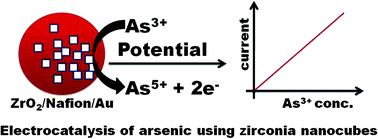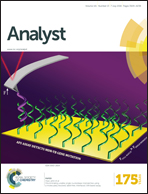Robust and direct electrochemical sensing of arsenic using zirconia nanocubes†
Abstract
The presence of heavy metal ions in the environment and in food items can severely harm human health. Thus, simple, reliable, sensitive, quick, and accurate methods for their detection must be developed as a means to improve healthcare worldwide. To this end, a robust method was developed for the direct sensing of arsenic(III) in control and real environmental samples (at neutral pH) by a gold electrode that was modified with zirconia nanocubes synthesized via a facile hydrothermal route. This sensing system was used to build a sensing profile for arsenic ions after characterization of their elemental, optical, chemical, and morphological behavior. Electrochemical sensing of arsenic was achieved by cyclic voltammetry (CV) and chronoamperometry with an ultra-sensitivity of 550 nA cm−2 ppb−1 and a detection limit of 5 ppb (linear range of 5–60 ppb with a response time below 2 s). Although this system experienced small interference from Cd ions, the results of the real sample analysis were comparable to those of other standard techniques. The proposed method is advantageous and can be used to assess the toxicity of water, food, and other environmental samples without requiring any toxic solutions and/or gasses in any of the analytical steps. Moreover, due to its low price, portability, and easy mass production, it can be adopted for use in screen-printed electrodes.


 Please wait while we load your content...
Please wait while we load your content...